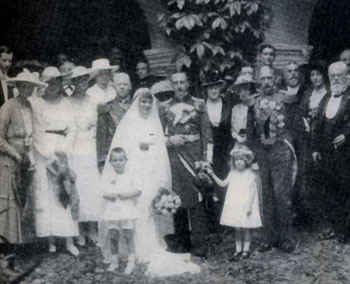 |
Book Reviews
The Catholic Resistance to Nazism in Germany
Judith Fife Mead & Marian Therese Horvat
Book review of Holding the Stirrup: The Memoirs of Baroness Elizabeth von Guttenberg
Post Falls: Lepanto Press, first published in 1953, 270 pp.
The Memoirs begins with a little girl making her way through the endless halls to her father’s study in the ancient family Castle of Tann, built on a high hill of fragrant pines in lower Bavaria. This summer she is determined to conquer her fear of ghosts to please her father, who wants her to show more courage.
With this scene, we enter the noble world of old Bavaria in the early 20th century, a world steeped in tradition and ceremony. For us, turning the pages of this book brings a breath of fresh air, a welcome contrast to the suffocating vulgarity of our modern times. Here in the castles and country homes we still find an aristocracy with high Catholic morals, whose formation prepares its members for a life of duty and sacrifice. In the countryside we meet a simple and strong people with a warm affection for the old noble families.
Holding the Stirrup is the autobiography of Baroness Elisabeth von Guttenberg (1903-1960), daughter of General Baron von der Tann-Rathsamhausen of Bavaria and the Countess Emma Mikes of Hungary. In truth, she had much need to conquer her fears as a child, for she would face many dangers that demanded great courage. In her life she saw the end of the Prussian Empire in 1918 and the founding of the Weimar Republic, which abolished the privileges of the German nobility. Then she saw its collapse in 1933 with the rise of Hitler’s Third Reich.
The changing history of her country is reflected in her life. The previous elevated and stable life of the old Bavarian nobles comes abruptly to an end, crushed by Republicanism and Nationalist Socialism.
We believe this book should be required reading for Catholic youth of our day. It explodes many common myths and lies that modern history strives to impose on the public as a whole. We will list two.
A healthy social atmosphere
Contrary to stories of class struggle with a corrupt aristocracy exploiting the people, the Baroness’ narrative brings to the fore the organic and healthy atmosphere of life in old Bavaria and Hungary. Hers was an arranged marriage, and Elisabeth was very happy to wed the young Baron Enoch von Guttenberg. The new couple was deeply committed to each other, and to their mutual duties before their subjects.

Enoch and Elisabeth von Guttenberg on their wedding day |
Many of the people of Guttenberg and of the Baron’s lands were present to welcome the newlyweds as they arrived in the courtyard of the Castle. The Baron’s younger brother delivered the key of the Castle to the new mistress on a velvet cushion. The Baroness recalls the strong impression this act made on her: That key for her symbolized “honor and responsibility - yes, a grave responsibility.”
The good customs and discipline in the home can be glimpsed throughout the reading: dressing for dinner, even when alone; the Herren (Lords) visiting the chapel before bed to say their night prayers; serious conversations among the men on the important religious or political topics of the day.
The book pictures a world where harmony among the classes was remarkably present and where a noble class with high ideals, serious dedication to the common good, and a sense of duty could be found.
Anti-Nazi resistance of the Catholic nobility
The heart of this book, however, is the reaction of the Catholic noble families against the rise of Nazism in Germany. Today, many youths imagine that the sole purpose of Hitler’s Third Reich was to kill and persecute the Jews, supposedly the only victims of the socialist regime. The reality is not so simple. This Jewish-dominated theme is a distortion of a biased media propaganda, strongly supported by Hollywood, which has been meticulously taken up by the present day education system. It was not just Jews, however, who suffered under the Third Reich. The Catholic nobility was also strongly persecuted by the Nazis.
From the onset of National Socialism, Baron von Guttenberg and his circle of friends realized the dangers it presented to their country and the Catholic religion, and they made efforts to fight it. In 1933 the Baron was at the heart of the failed attempt by the monarchist party – led by military of many of the old Catholic families – to establish a constitutional monarchy in Bavaria, a failure that resulted in Hitler seizing the power of government. The nobility paid a heavy price for their opposition to National Socialism. More than a thousand members of the burgeoning resistance to the Nazis met death or imprisonment on the orders of Hitler, who wanted to smash the monarchist party and any organized opposition to his regime.
The German resistance was the opposition that rose against the National Socialist regime between 1933 and 1945. It was never a united, organized front, but rather small cells and isolated groups who opposed Nazism. The Baroness writes: “Many of the men who worked unceasingly for years never knew each other or those outside their own small group. Extreme caution and secrecy were of the utmost importance, for the Gestapo was relentless in its effort to find them, and the price of discovery was death.” (p. 129)

Claus von Stauffenberg, nephew of Baroness Elizabeth von Guttenberg |
In that first Nazi purge of the German nobility, the Baron was imprisoned, and Elisabeth had the opportunity to demonstrate the courage she had learned as a girl. She did not fear to go to the Nazi headquarters in Munich to make inquiries to discover where her husband was – a dangerous pursuit that could end in her own arrest. She persisted in her demands for his release, knowing that every hour that passed might be the hour of his death. Eventually he was released but afterwards the family was under constant surveillance by the SS.
A second purge of the German nobility came in 1944, after the failed attempt to assassinate Hitler on July 20, 1944. The plot was led by Claus von Stauffenberg, the son of Elisabeth von Staffenberg, Baron von Guttenberg’s sister. The bomb he planted in a military conference room went off, but failed to kill the Fuhrer. Hitler’s revenge was swift and brutal. Claus von Staffenberg was shot by an Army firing squad, his last words “Long live my holy Germany.” Orders came for all bearing that family name – man, woman or child – to be killed, along with everyone who had been in any way involved with the failed attempt.
“All of our friends, practically all the men of our family were involved in the ‘plot,’” writes Baroness Guttenberg. Consequently, most were killed or imprisoned as the nation was awash “in the blood of the country’s most brilliant and courageous men, the men who should have lived to rebuild a new Germany.” By the end of the purge, more than 4,000 had been killed. Sadly, there is little said today in history books about this tragedy and heroism of this German resistance movement.
We cannot close this review without noting the admirable spiritual journey of the Baroness as she faced personal adversities and the growing threat of the Third Reich. At the end of her book she turns her gaze on the recuperating post-war Germany and expresses her concern because “the spiritual recovery has not kept pace with the material” (p. 268).
A word about the title Holding the Stirrup: Tradition called for the wife to hold the stirrup for her husband as he mounted his horse to ride into battle. Baroness Elisabeth von Guttenberg faithfully performed this service, holding the stirrup for her husband to fight in the anti-Nazi resistance, in spite of the danger to herself. After his death, she continued to hold the stirrup for other members of her family, remaining faithful to duty and the fight against evil.

Posted June 17, 2011

Related Topics of Interest
 Nazism a Gnostic Manichean Sect Nazism a Gnostic Manichean Sect
 Organic Society Organic Society
 TIA - Neither Nazi nor Anti-semitic TIA - Neither Nazi nor Anti-semitic
 A Man’s Bearing Reflects His Education and Virtue A Man’s Bearing Reflects His Education and Virtue
 Refinement and Sanctity Refinement and Sanctity
 Catholic Customs Remembered Catholic Customs Remembered
 Nobility and Accessibility: Keys of Catholic Charity Nobility and Accessibility: Keys of Catholic Charity

Related Works of Interest
|
|
Book Reviews | Home | Books | CDs | Search | Contact Us | Donate

© 2002-
Tradition in Action, Inc. All Rights Reserved
|
 |

|